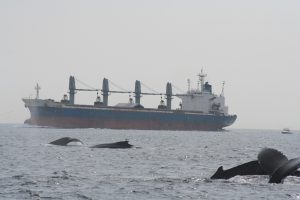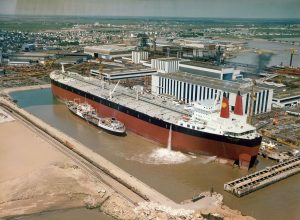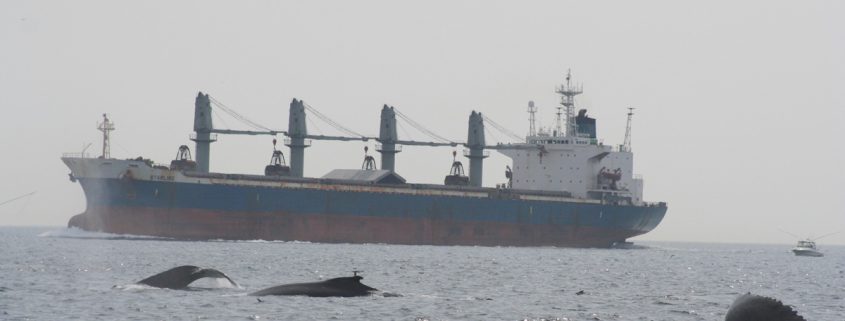A coming boom in commercial shipping? The potential for rapid growth of noise from commercial ships by 2030
By Josh Ratay, SRC intern
A coming boom in commercial shipping? The potential for rapid growth of noise from commercial ships by 2030 by Kaplan and Solomon is a new study examining potential increases in oceanic noise between 2016 and 2030. Reduction of anthropogenic (human-caused) sounds from commercial shipping has long been recognized as important due to possible impacts on marine life (see https://www.ncbi.nlm.nih.gov/pmc/articles/PMC4626970/). However, previous studies have been limited in scope to just a few coastal areas, and have had limited success at showing the effects of noise across the whole ocean.

Increased noise from commercial shipping can have negative effects on marine animals, particularly those sensitive to sound. Photo from nefsc.noaa.gov.
Here, Kaplan and Solomon combined existing data on commercial fleets with projections of future growth to estimate worldwide shipment and noise levels between now and 2030. The study focused on three classes of ships: container ships, oil tankers, and bulk carriers. The projections suggest a doubling of container and bulk ships in the next 15 years, contributing to an expected 87% increase in sources of marine noise based on ship quantity alone. However, the actual increase is likely to be greater than 87% because ships are also predicted to increase in size. Today, only 1 in 5 container ships can carry 7600 or more 20-foot containers. This is expected to increase to about half of all ships (48%) by 2030. These larger ships output more noise than smaller ones and thus further drive up ambient noise levels in the ocean.
Furthermore, the average distance travelled per ton of shipping material is expected to increase, driving up the time that large, high-noise ships spend at sea. This is related to increased globalization and availability of new shipping routes. For example, a planned expansion of the Panama Canal would allow larger ships to travel further distances and into new areas.

The shipping routes of the world. Increased traffic along these routes leads to increased underwater noise. Image from Wikimedia Commons.
While this study focused mainly on large, commercial ships that traverse the open ocean, noise increases in small, coastal, recreational craft are also significant. Though they add less ambient noise to the oceans, their continuous, high frequency sounds can have significant impacts on the nearby shallow-water environments. Further studies of these impacts are greatly needed.

The supertanker Batillus, one of the largest ships ever built. Large commercial ships produce more noise than those of moderate size and are expected to become more common in the coming decades. Image from Wikimedia Commons.
The final estimate for noise increase by 2030 was 87 to 102%: quite a significant amount, and large enough to call for increased management. Proposed strategies include speed reductions in high traffic areas along with the development of inherently quieter types of ships. Though guidelines exist regarding ship noise levels, they are currently not mandatory, so a firmer policy could drive the adoption of these noise-efficient ships. Future research could create standard methods of measuring noise levels that could be implemented at shipping ports. This would improve management effectiveness, and similar practices are already used at airports to measure airplane noise. Overall, this study shows that additional research and policies are required for this important yet little-understood area of marine conservation.
Reference
Kaplan, Maxwell B., and Susan Solomon. “A coming boom in commercial shipping? The potential for rapid growth of noise from commercial ships by 2030.” Marine Policy 73 (2016): 119-121.




Leave a Reply
Want to join the discussion?Feel free to contribute!